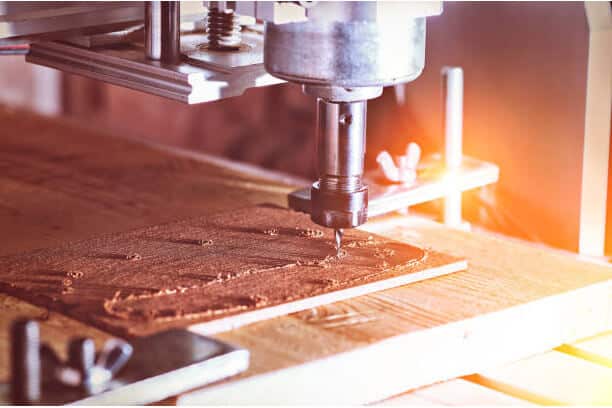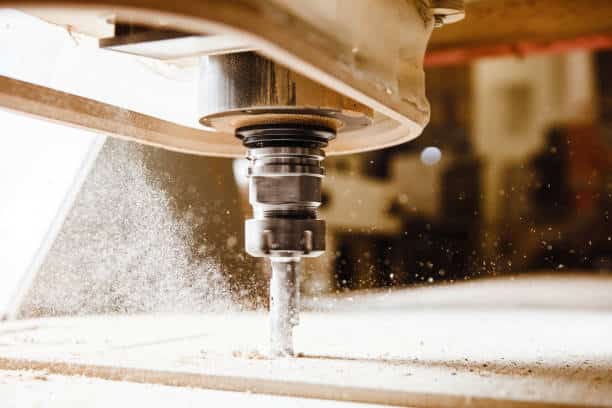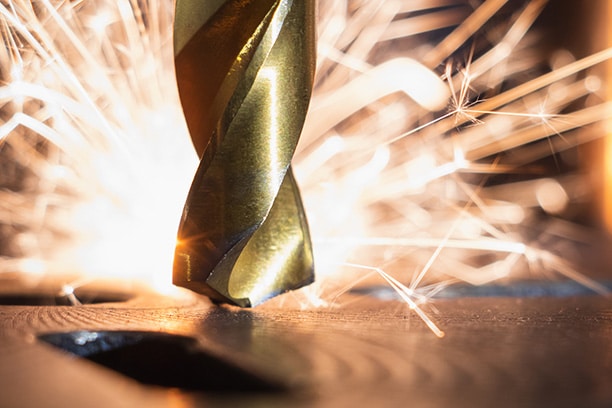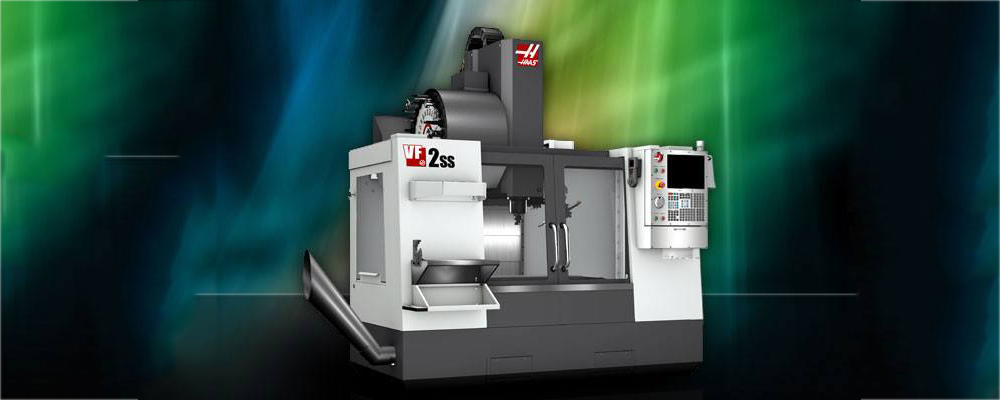CNC wood routers play a significant role in woodworking jobs as they provide precision and accuracy in the fabrication of a wide range of materials and components. They are used to create detailed components, 3D shapes, and intricate designs by cutting and shaping wood, plastics, and other materials. They can also be used for drilling, routing, edge joining, and engraving. CNC wood routers are used in furniture making, cabinetry, wood carvings, and inlay work. They are also used in the production of custom parts and tools for woodworking and other manufacturing industries.
In this article, we’ll specify the definition, types, structure, and considerations of the CNC wood router. Let’s read further to find these answers.
What Is A CNC Wood Router & How Does It Work?
Similar to any other CNC machine, a CNC wood router is a Computer Numerically Controlled (CNC) system which utilizes computer software and electronics to drive a mechanical system. This setup allows for a higher degree of accuracy and precision than a manual operator. This automatic machine performs smart 2D, 2.5D, and 3D cutting, milling, drilling, grooving, and carving on woodworking plans to operate cabinet making, signs making, modeling, door making, wood arts & crafts, wardrobe, furniture, decorations, and more ideas or projects.
The CNC wood router is capable of moving and cutting in three directions generally referred to as the X, Y, and Z directions. The X-axis is the longest of the three, running front to back, the Y-axis runs from left to right, and the Z-axis runs up and down. Thus, it is highly efficient as it can work in all three directions in near-perfect synchronization, allowing it to carve complex shapes.
Structure of A CNC Wood Router
Let’s overview the main parts of these machines and see how they fit together to make it all work. The picture below shows the main components of a common CNC wood router. Even if there are many other components and add-ons, most routers have these common components.
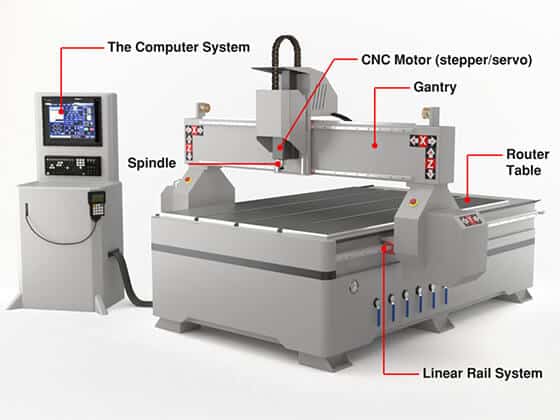
The CNC Controller and Computer System
The CNC controller and computer system act as the “brain” for these machines, providing instructions to the motors and drive system about what direction to move and how far.
The user begins by inputting a digital design, typically in a dxf drawing or similar format. Using CAM software, the design is then converted into tool path code, such as G-code, which is understood by the computer. This code is transformed into a digital signal that is relayed to the CNC controller, and ultimately converted into varied voltages and currents that manage the mechanical drive systems.
While the user interface depends on the type and manufacturer, the general process requires the use of digital design and additional software to create tool paths for the machine to use.
The Spindle
The spindle is the component of the machine responsible for the cutting process. This router spindle is determined by its power capability – power is measured as horse power (English units) and in Watts (SI units). To carry out the cutting process, the spindle will rotate a cutting tool – usually router bits – at varying speeds. A spindle used to cut wood, plastics, and other soft materials will usually operate at 8000 to 30,000 revolutions per minute, while spindles designed to cut metals typically operate between 2000 and 10,000 RPMs.
CNC wood routers are usually able to cut metals, though this capability is usually limited to non ferrous metals such as aluminum. When cutting metals or carbon based composites, a coolant system is necessary to cool the material and tool being used. Additionally, the spindle can be controlled by the CNC controller, which regulates the RPM based on the material and the machine’s feed rate. Other options for the spindle may include an automatic tool changer, tool sensor, and touch probe.
The Cutting Bed
The cutting bed is a necessary component in any cutting process. It is designed to securely hold the material in place while being cut. Different types of cutting beds can be found, the two most common being the T-slot and the vacuum table.
The T-slot, pictured above, is a versatile design that holds almost any size and shape of material but lacks speed and efficiency in setup. The vacuum table is found in many high-end models and is great for materials that are relatively flat such as wood and sheet material. It is most efficient when cutting the same design multiple times a day.
Additionally, there are hybrid designs combining both the T-slot and vacuum designs. No matter the type, the cutting bed is essential for a successful cutting process.
The Linear Drive Systems
The CNC linear drive system utilizes a motor, linear bearing system, and lead screw assembly to move the spindles in each axis.
Two types of motors are often used in CNC wood router machines: stepper motors and servo motors. Stepper motors are an economical choice and are generally reliable but offer an open loop system, while servo motors offer a closed loop system where they send a signal back to the controller confirming the task is complete.
Closed loop systems are typically found on higher-end models. The type of motor dictates the type of controller used. Rotational motion from the motor is converted to linear motion by the lead screw assembly which is coupled to the linear bearing assembly.
Different designs use different systems for this conversion, such as lead screw and nut assembly, ball screw and nut assembly, and rack and pinion assembly. Each system has its own benefits and drawbacks, which can be researched further in other areas of our website.
Other Features
A CNC wood router typically uses a gantry style design which consists of a Y-axis assembly suspended above the cutting bed, gliding on a linear bearing assembly to move along the X-axis. The base of the machine holds everything together.
Summary
The principle of how a CNC router works can be simply summarized: commands are given to the CNC controller, which controls the motors that turn the linear drive system. This system then moves the spindles in three dimensions, rotating the cutting tools rapidly to carve the material that is being cut.
Learn more about our CNC Machining Wood Capability
Types of Wood CNC Machines
- Based on axis
- 5 axis CNC machines for woodworking
- 4 axis CNC woodworking machines
- 4th axis (rotary axis) CNC woodworking routers
- 3 axis CNC wood routers
- Based on applications
- Home types
- Desktop types
- 3D types
- Hobby types
- Commercial types
- Industrial types
- Based on table sizes/work area
- 2×3 table tops
- 2×4 table tops
- 4×4 table tops
- 4×6 table tops
- 4×8 table tops
- 5×10 table tops
- 6×12 table tops
10 Tips for Using the CNC Wood Router
- It is better to use setscrews rather than tabs, as many people find it difficult to strike a balance with using enough setscrews. To secure the material you are making, make sure to create holes on the spoil board beforehand.
- It is important to adjust the feed rate according to the pass for optimal results. A good feed rate for plywood is 80 inches per minute, with a cutting depth of 0.4 inches.
- To ensure a full depth cut, target a cutting depth that is deeper than the actual material thickness.
- Using a lossless design by placing components as close together as possible can save time and money.
- Limiting the number of flutes ensures that large chips can escape and there is enough space between the cutting edges.
- To increase RPM, it is recommended to use cutters with smaller diameters, reducing their size by ¼ of the actual diameter.
- Prior to cutting, you must make sure that the CNC is in a square or has gone through proper calibration in order to ensure that the input and output match up.
- You must also choose the appropriate shape of the bit as it affects both the feed rate and the edge of the product. Compression bits are ideal for creating a smooth surface on all sides.
- When machining the material, use the correct end mill as there are many different types available.
- For precise and clean cuts, it is important to use different roughing and finishing operations during the CAM stage. The initial stage will ensure a wide cut, while the final stage will ensure a clean edge.
Rely on Runsom’s Custom CNC Woodworking Services
Runsom is a precision CNC machining manufacturer supplying custom woodworking services. We introduce a full set of top-notch CNC equipment, such as CNC router machines, CNC lathes, CNC mills, and 5-axis CNC machining centers, which makes it possible to create prototypes, small-scale, and mass production with highly efficient and precision cuts. Start your CNC woodworking projects with a rapid quote right now!
Other Articles You May be Interested in:

